Heading out the door? Read this article on the new Outside+ app available now on iOS devices for members! Download the app.
11 Photos of the World’s Wildest Sea Cliff Climbs
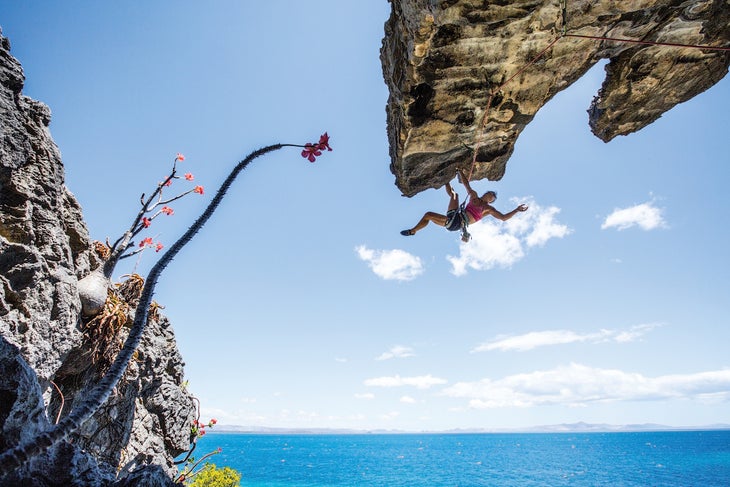
Location: Nosy Anjombavola, Nosy Hara Archipelago, Madagascar
Climber: Mayan Smith-Gobat
Climb: Tafo Masina (5.13b)
Coastal environments tend to be windy—really windy. Whitecaps dot the blue canvas of the sea in all directions. I’m no biologist per se, but the isolation of and microclimates on islands have allowed for the evolution of endemic plant species beyond your wildest dreams. It’s like Dr. Seuss meets Alice in Wonderland. The more remote, the more psychedelic, and Nosy is no exception. Things can get funky here. Pink, flowering, thorny bottle bushes? Yes, please. And hey, they even match that top over there: Double bonus!

Location: Socotra Island, Socotra Archipelago, Arabian Sea, Yemen
Climbers: Jonathan Thesenga, Brittany Griffith
Climb: Sea bouldering
Socotra is a sliver of hope surrounded by seas of violence and hostility: It’s bound on one side by the Gulf of Aden, and the closest mainland country is Somalia, with its pirate-infested waters. Nonetheless, Socotra remains a peaceful place. Classified as a microcontinental island (sounds much bigger than it is), it was ripped from Africa during a rift.
Socotra has been hailed as the jewel of biodiversity in the Arabian Sea. Over 700 endemic species live here, numbers topped only by a few other islands in the world. The dragon’s blood tree is the island’s most bizarre specimen, with a singular shaft rising to a spectacular, umbrella-like pointy penthouse. The desert rose—or bottle tree—is a close runner-up and has been described as a blooming elephant’s leg. While a lifetime of granite spires dot Socotra’s skyline, there are only a few climbable limestone blocks in the water. The climate is hot, but the ocean is blissful and the people are peaceful. I encourage everyone to visit via Dubai, not mainland Yemen—if you’re American, you probably know why.

Location: Azure Window, Gozo, Malta
Climber: Matt Segal
Climb: Unknown hardman route
I was asked the other day what I fear. I thought about it awhile and came to the conclusion that I fear objective danger: I fear catastrophic collapse; I fear geologic time. With respect to humans, geologic time crawls by: It’s so slow, it’s hard to comprehend until something big happens. A few years ago outside Moab, Utah, when a little mud tower named the Cobra fell over, no one was surprised. But in March of this year, a few months after we had visited, the Azure Window fell into the sea. It had been beaten and battered by wind and waves for eons and was bound to collapse someday. But now that it’s gone, visibly so, in our lifetime, it quantifies geologic time in a tangible way, one that makes you feel frail and all too mortal. RIP, Azure Window. I’m glad we weren’t climbing on you when you disappeared into the sea.
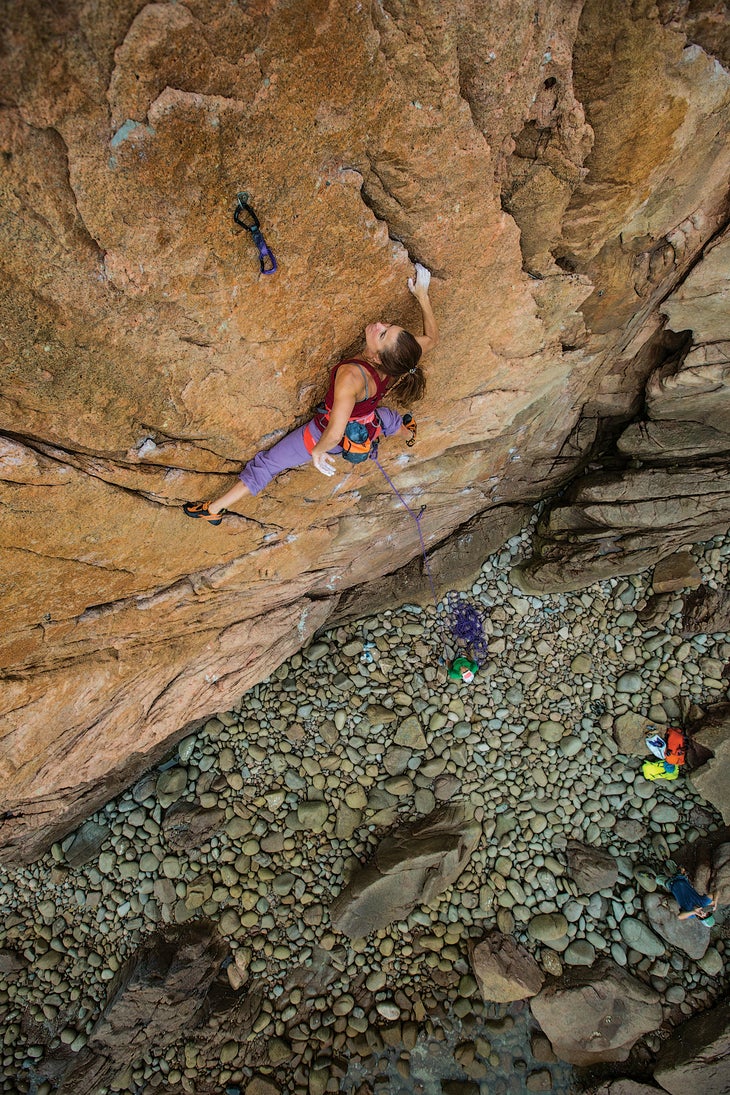
Location: Hanagae Beach, Muuido Island, South Korea
Climber: Brittany Griffith
Climb: Dancer’s Dress (5.9)
The air was thick and stagnant, either with fog or perhaps smog from the nearby city of Incheon. While not isolated in the classic island sense, this tiny islet off the coast of mainland South Korea did provide solitude—away from the hustle, the bustle, the madness, and even the nearby international airport just across the way.
Climbing here is tide dependent: The routes are only accessible when the moon pulls the sea away and stacks the water on the other side of the globe. As we climbed, a few small crabs ran across the freshly uncovered wet cobbles below the cliffs, only to be harvested by the local climbers. If there is one thing I learned in Korea, it’s that climbing is just an excuse to have a grand, family-style picnic. The Korean climbers lay out their blankets and pull an assortment of containers and liquor out of their packs. Someone peels garlic and tosses it along with the coin-sized crabs into a pot. Then, everyone digs in with chopsticks, plucking entire crabs from the broth. Source to belly, less than 100 feet and within 10 minutes—now that’s crag chow.
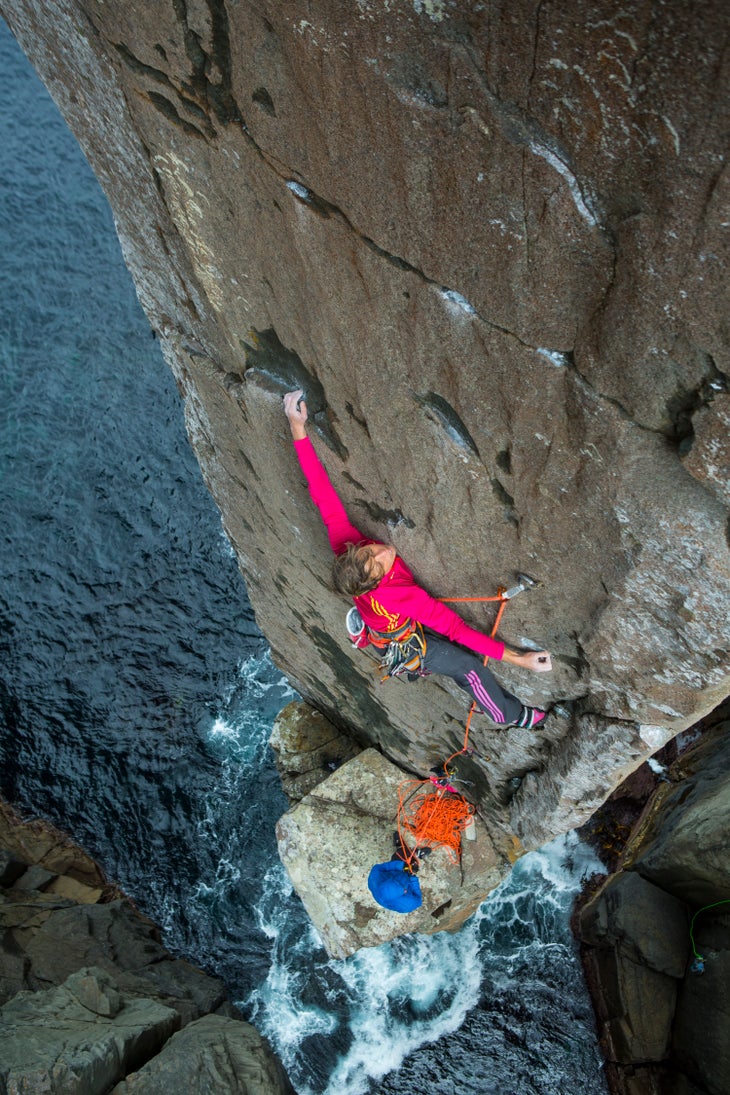
Location: Cape Huay, Tasman Peninsula, Tasmania
Climbers: Mayan Smith-Gobat, Benjamin Rueck
Climb: The Free Route (5.12a), Totem Pole
Considered by many to be the most iconic sea stack in the world, the Totem Pole is miraculously uniform from top to bottom. Picture a matchstick; now enlarge this until it rises more than 200 feet from bitterly cold waters. To reach the climb, you must pendulum from the mainland on the end of your rappel rope, across a 20-foot channel, and grab the tower. Mind you, you’re not gunning for jugs, but single-pad crimpers. If you don’t stick the move, be prepared to slam back into the wall behind you. And forget it if the sea isn’t calm; walk away and save it for another day. You will likely drown. Did I mention that the Totem Pole sways in the wind? The fear is real.
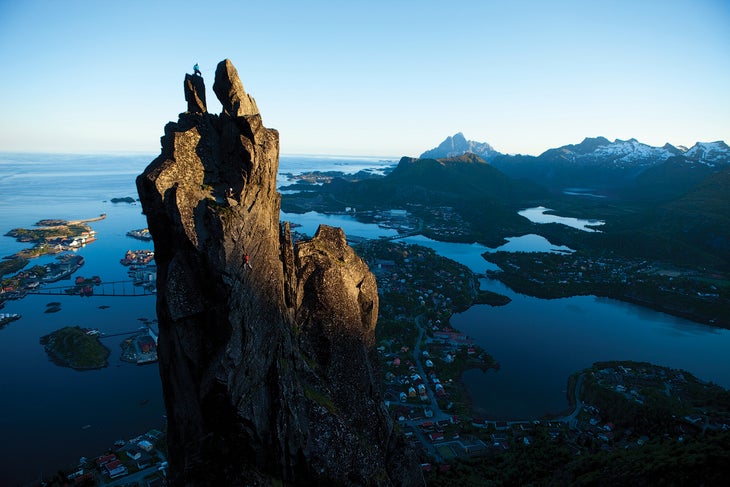
Location: Svolvaergeita, Svolvaer, Lofoten Archipelago, Norway
Climber: Brian Heppner (in red)
Climb: Rapellruta (5.6)
I’ve spent a healthy dose of my life climbing above the sea, but the evening pictured here was especially magical. It’s not hard to understand why this cluster of islands in the Artic Circle is affectionately known as the “Magic Islands.” It was after midnight as the sun’s rays kissed the horns of the formation that locals call “the goat.” The evening was dead quiet—no wind, not even a breeze, which is almost unheard of for this far-northern latitude. Smooth as a plane of glass, the sea mirrored the beautiful blue hues of the midnight sky. It was a golden hour that lasted half the night as the sun skimmed the horizon and I told myself that I needed to shoot in evening light more often.

Location: Motutakae, Ua Pou Island, Marquesas Islands, French Polynesia
Climbers: Mason Earle, George Ullrich
Climb: West Face (5.11a FA)
The Marquesas are as isolated as it gets: smack dab in the middle of the Pacific. We came to Ua Pou in 2013 to climb an inland basalt tower called Poumaka. Mason and George wanted to put up a free climb in impeccable ground-up style, but the microclimate that the inland mountains created and the lack of holds washed us away. After a few days sailing about and with a little luck, we found an 800-foot climbable tower, Motutakae, rising from the ocean on the southern tip of Ua Pou. Nesting seabirds occupied the ledges, threatening to vomit sardine bile all over us. Commitment was high when the crumbly limestone cracks dissipated and we had to bolt on lead, which we did sparingly, even though only seabirds were there to bear witness. Gigantic manta rays cruised the ocean below like a fleet of battleships. Motutakae cast a great pyramid shadow across the depths like a Himalayan giant projecting itself onto the cloud ceiling at sunrise. This is why I climb above the sea: the smell, the taste, the visuals beyond your wildest dreams.
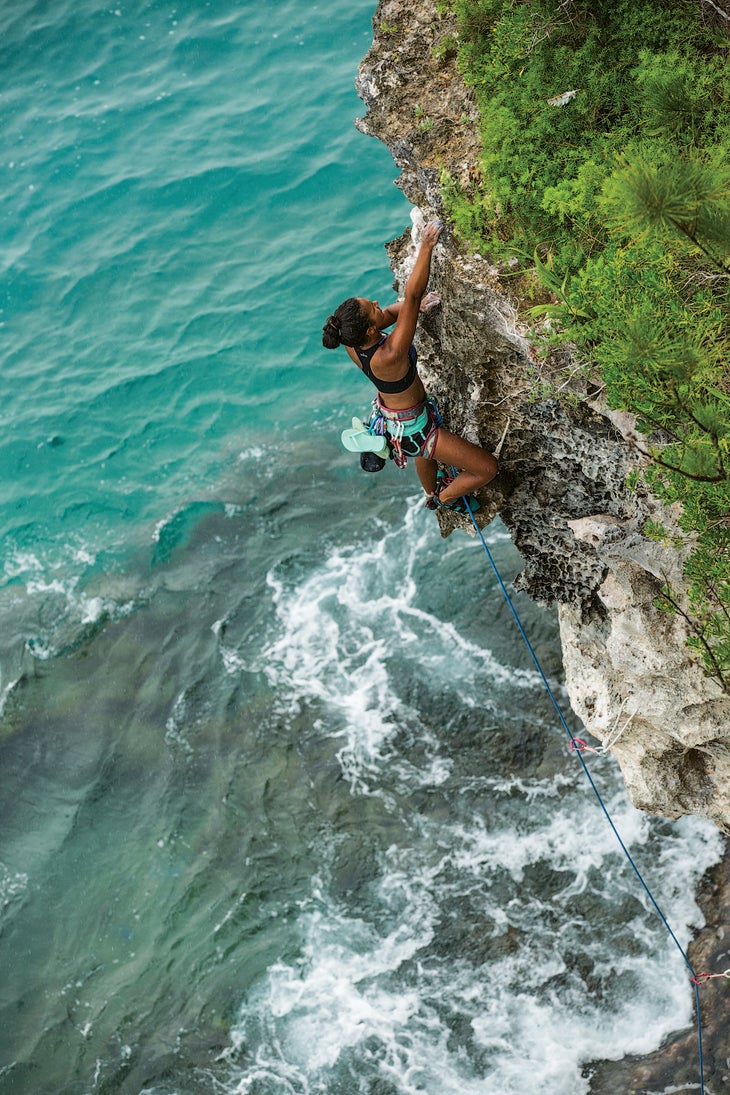
Location: Nereid’s Wall, Great Head, St. David’s Island, Bermuda
Climber: Jazmyne Watson
Climb: Succubitten (5.10a)
The rain began soft, thin, and nearly undetectable as waves exploded below the belay. Squalls ripped across the open ocean from far, far away. As we climbed, stranded on this tiny island in the Atlantic, the turquoise waters provided a sense of calm as the rain rejuvenated salt-encrusted pores, bringing skin back to life. Chapped lips began to fade. The coolness of the rain brought relief from the stifling summer humidity. Holds got damp, but we kept it easy as we tried to top out before the brunt of the storm arrived. The sea is hostile, even in paradise. Bolts rust. Quickly. Drilled threads seem to be the answer here—easily replaced and quite safe. It’s the little things that make insanity feel rational.
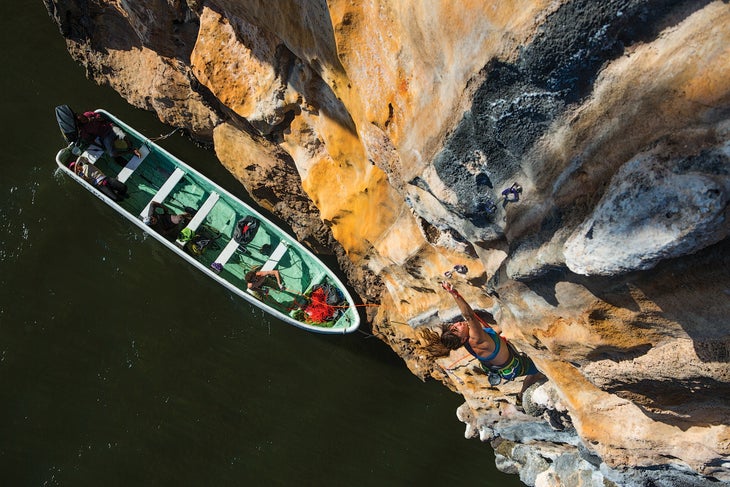
Location: Wizard’s Sleeve, Samana Bay, Parque Nacional Los Haitises, Dominican Republic
Climber: Brittany Griffith
Climb: Presidente de la Sol (5.13 FA)
Located near the northwestern corner of the island, devilishly close to the lower boundary of the Bermuda Triangle, lies tranquil Samana Bay. We traveled to the eastern side of the Carribean island during December, trying to hit their winter to avoid sizzling in the equatorial sun. Fat chance: While the locals wore puffies, we scratched our heads as we stripped down to the bare minimum to let our skin breathe in the 90-degree heat and stifling humidity. After hiring a boat, we sped through the racetrack-like maze of mangrove tunnels that lead to the bay. We traversed miles of shoreline, stacked with potential limestone cliffs, until we settled on two routes that emerged from the rocky, mussel-encrusted seabed. We named this route after the local beer, but added the sun: la sol. Seemed fitting: No matter how fast we drank, we never could finish a beer before it got warm.
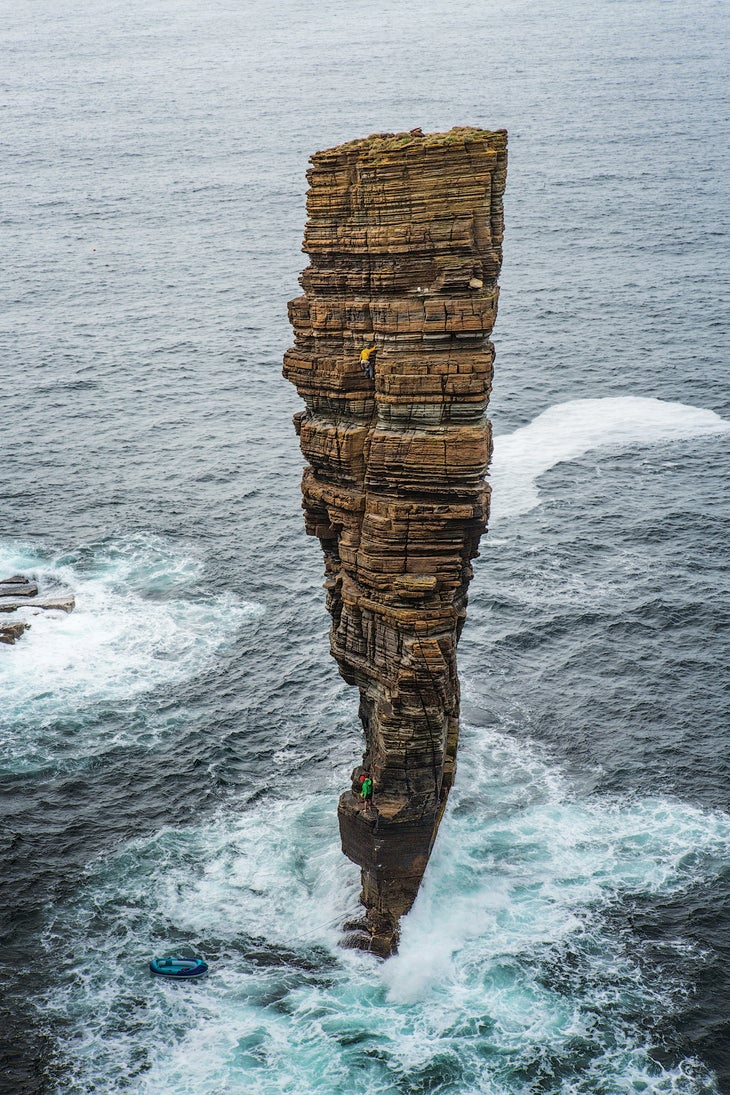
Location: North Gaulton Castle, Orkney Archipelago, Scotland
Climbers: Peter Vintoniv, Andrew Burr
Climb: The Original Route (5.9)
Enough of this sun-drenched, dreamy limestone. Lets get metal—heavy metal. Located at the northern tip of Scotland are scads of crumbly Old Red Sandstone, forming mainland cliff bands and myriad sea stacks. The ocean is cold and foreboding. The water here is no joke: Michael Reardon lost his life in 2007 in nearby Ireland when he was swept away by a rogue wave that rose out of the turbulent black seas. He was never seen again.
Peter and I probably shouldn’t have been in the ocean that day, amidst the booming, breaking waves, but the allure of this inverted, top-heavy tower was too strong. Somehow, our dinghy approach worked (we rapped off the mainland with the boat already inflated, then paddled over), and the tower stood strong against the storm’s swell. The waves were “only” 10 feet tall, but at sea level they felt like skyscrapers. The climbing proved to be the easiest part of the day, with numerous horizontals guiding the way to the summit.

Location: Sotil, Menorca, Balearic Archipelago
Climbers: Steve Fassbinder, Rachel Landis
Climb: Lacayo Hispanoparlante (5.10a)
I’ve never experienced the postcard Mediterranean Sea—when the sea air is blissful, sunbathers line the beach, and you might see a mermaid slink into the blue-green depths. I only seem to visit in winter, when the seas are inhospitable. Whitewater churns like a class V rapid, and the decibels reach thunderous magnitudes. The cliffs vibrate with a nervous energy that makes the hair on the back of your neck stand up. You overgrip. You try too hard. You’re scared. You’re exhausted. Mentally fried. It’s magical; it’s sensory overload. I can’t avoid it. I keep coming back. The mesmerizing, hypnotic motion, crashing waves exploding in towering plumes of white, the beckoning temptations of translucent teal shallows, the steely blackness of the abyss, the siren song, the undeniable obsession to hear her call. I will come again for you.
Climbing above the ocean requires a healthy sense of adventure. The sea has many moods, from tranquil like an infinity pool to hellish, cold, and “angry,” as the English would say. The oceans generate the worst storms in the world. Warm currents in the water humidify the air, causing it to rise and condense into vast, violent storms that rage across the globe, unchecked by land. Thousands of miles of coastline snake along the seven continents, but when you reduce that loop to the size of an island, the weather is concentrated, feelings are intensified, senses are amplified, and isolation prevails—there is nowhere to hide. It’s sensory and commitment overload. Small, vulnerable, and exposed to the elements, you might as well be Santiago from The Old Man and the Sea, questioning the meaning of “success.” You’re either sizzling in the sun hoping to fall into green-blue seas or scared shitless as breakers pound the cliff, threatening to rip your belayer into the drink.